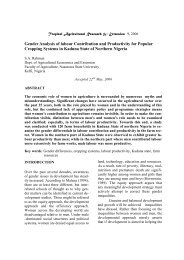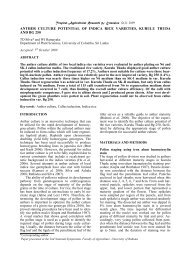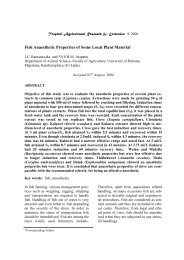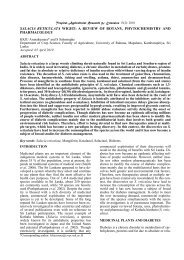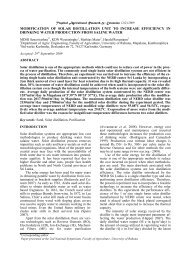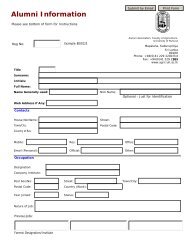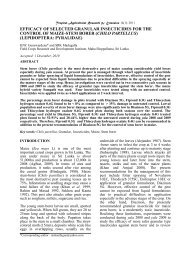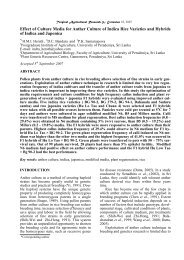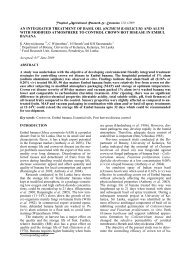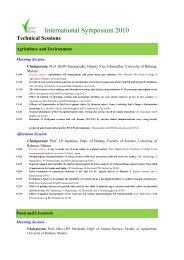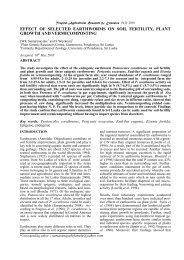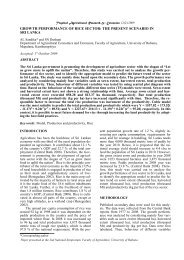Print this article - Sri Lanka Journals Online
Print this article - Sri Lanka Journals Online
Print this article - Sri Lanka Journals Online
You also want an ePaper? Increase the reach of your titles
YUMPU automatically turns print PDFs into web optimized ePapers that Google loves.
Tropical Agricultural Research & Extension 12(2):2009<br />
GROWTH PERFORMANCE OF RICE SECTOR: THE PRESENT SCENARIO IN<br />
SRI LANKA<br />
AL Sandika* and SN Dushani<br />
Department of Agricultural Economics and Extension, Faculty of Agriculture, University of Ruhuna,<br />
Mapalana, Kamburupitiya<br />
Accepted: 1 st October 2009<br />
ABSTRACT<br />
The <strong>Sri</strong> <strong>Lanka</strong> government is promoting the development of agriculture sector with the slogan of “Let<br />
us grow more to uplift the nation”. Therefore, <strong>this</strong> study was carried out to analyse the growth performance<br />
of rice sector, and to identify the appropriate model to predict the future trend of the sector in<br />
<strong>Sri</strong> <strong>Lanka</strong>. The study was mainly done based upon the secondary data. The growth performance was<br />
analyzed by considering mainly four variables such as sown extent, harvested extent, total production<br />
and productivity. Then, behaviour of different variables was tested by using scatted plot diagram with<br />
time. Based on the behaviour of the variable, different time series (TS) models were tested. Sown extent<br />
and harvested extent have not shown a strong relationship with time. Over the years average sown extent<br />
and harvested extent were 858.28 and 813.37 ha thousand, respectively. But total production<br />
(thousand Mt) and productivity (kg per ha) have increased significantly with time. Therefore, the responsible<br />
factor to increase the total rice production was increasing the productivity. Cubic model was<br />
the most suitable to predict the total production and productivity which were Y = 1557.82 + 173.52t -<br />
11.17t 2 + 0.24t 3 (r 2 = 89.51) and Y = 2227.67+ 210.13 t - 11.19t 2 + 0.22t 3 (r 2 = 95.20) respectively. In <strong>this</strong><br />
context, it is possible to meet future demand for rice through increasing the land productivity by adopting<br />
the best field practices.<br />
Key words: Model, Production, Productivity, Rice,<br />
INTRODUCTION<br />
Agriculture has been the backbone of <strong>Sri</strong> <strong>Lanka</strong>n<br />
economy with one-third of the rural population dependent<br />
on agriculture. It contributes about 12.1 %<br />
of the country’s GDP and 32.7 % of the total employment<br />
(Central Bank 2008). Therefore, the Government<br />
is promoting the development of agriculture<br />
sector with the slogan of “Let us grow more<br />
food to uplift the nation”. Rice is the principle contributor<br />
of the rural economy as the majority (72%)<br />
of rural households is engaged in production of rice<br />
as their main and supplementary source of livehood<br />
(Henegedara 2002). Rice is the main crop cultivated<br />
by the majority of farmers in rural areas and<br />
it is the staple food of the 18.6 million inhabitants<br />
of <strong>Sri</strong> <strong>Lanka</strong>. Further, it is the livelihood of more<br />
than 1.8 million farmers. Rice contributes 1.8 % of<br />
country’s GDP (Central Bank 2008). Rice is cultivated<br />
in almost all parts of the country, except at<br />
very high altitudes, as a wetland crop (Henegedara<br />
2002).<br />
The annual per capita consumption of rice was<br />
around 92 kg in 1998 and it was dependent on the<br />
paddy production in the country and the price of<br />
imported wheat flour. By 2008 it increased to 96 kg<br />
and total production was 3.88 million tons of rough<br />
rice (paddy), which is about 97.8 % of the national<br />
requirement. With the present population growth<br />
rate of 1.2 %, slightly increasing per capita consumption,<br />
requirements for seed, and for wastage in<br />
handling, <strong>Sri</strong> <strong>Lanka</strong> needs more than 4 million tons<br />
of paddy by the year 2010. Hence, it is projected<br />
that the national average yield should increase to<br />
4.4 t/ha to feed the population of <strong>Sri</strong> <strong>Lanka</strong> in 2010.<br />
However, the gross extent sown and production in<br />
year 2008 were 1.05 million hectares and 3.85 million<br />
tons. Paddy production in 2008 year was increased<br />
by 23.8 %, (Central Bank 2008). Therefore,<br />
<strong>this</strong> study was carried out to analyze the growth<br />
performance of rice sector in <strong>Sri</strong> <strong>Lanka</strong>, and to<br />
identify the appropriate model to predict the future<br />
trend on sown extent, harvested extent, total production<br />
and productivity of the rice sector.<br />
METHODOLOGY<br />
Published secondary data were used for <strong>this</strong> analysis.<br />
The data were collected from the Central Bank<br />
reports from 1977 to 2008. The growth performance<br />
was analyzed by considering mainly four<br />
variables such as sown extent (thousand ha), harvested<br />
extent (thousand ha), total production<br />
(thousand t) and productivity (kg per ha). Data<br />
were first tabulated. Then, behaviour of different<br />
*Corresponding author: sandika@agecon.ruh.ac.lk<br />
Paper presented at the 2 nd National Symposium, Faculty of Agriculture, University of Ruhuna
Sown / Harvested extent (ha 000)<br />
Production (000Mt) / Productivity (Kg/ha)<br />
72<br />
AL SANDIKA AND SN DUSHANI : GROWTH PERFORMANCE OF RICE SECTOR IN SRI LANKA<br />
variables was tested using scattered plot diagram<br />
against time factor (Ljung GM and Box GEP<br />
1978 ). Based on the behaviour of the variable, different<br />
time series (TS) models viz; linear model,<br />
polynomial such as Quadratic and Cubic models<br />
with the time factor were tested (Madridakis et al.<br />
1983). The different models have been shown by<br />
the following formulae.<br />
Linear model (Y = a + bX),<br />
Quadratic model (Y = a + b 1 X + b X 2 )<br />
Cubic model (Y= a +b 1 X +b 2 X 2 +b 3 X 3 )<br />
Where as, Y = production, X = time period,<br />
a = intercept and b, b 1 , b 2 , b 3 = regression coefficients<br />
The goodness of fit of models was tested by using<br />
coefficients of determination (R 2 ) (Majumdar<br />
2002). Coefficient of determination was measured<br />
by applying formula (i).<br />
R 2 = (y’- ÿ) 2 / (y-ÿ) 2 ……………(i)<br />
Whereas, Y = production, y’ = predicted production<br />
and ÿ= mean production<br />
Based on the selected best TS model, appropriate<br />
forecasting model for different variables of rice<br />
were developed.<br />
RESULTS AND DISCUSSION<br />
Performance of cultivated extent, harvested extent,<br />
rice production and productivity<br />
In <strong>Sri</strong> <strong>Lanka</strong>, rice is grown under a wide range of<br />
physical environments such as different elevations,<br />
soils and hydrological regimes. There is a wide<br />
range of climatic and soil conditions in the country.<br />
Based on the rainfall and elevation, seven major<br />
agro-ecological zones (AEZ) have been identified<br />
(LCDZ, LCIZ, LCWZ, MCIZ, MCWZ, UCIZ and<br />
UCWZ). These AEZ were further subdivided into<br />
24 agro-ecological regions, considering the rainfall<br />
distribution, soil type and the landform. Rice is<br />
grown in all the agro-ecological regions except in<br />
WU 1 , WU 2 , WU 3 and IU 2 . If water conditions are<br />
right, almost all kinds of soils could be used for rice<br />
cultivation. In <strong>Sri</strong> <strong>Lanka</strong>, the hydromorphic associates<br />
of almost all its great soil groups are used for<br />
rice cultivation (Panabokke 1996). Therefore, compared<br />
to many other rice growing countries, <strong>Sri</strong><br />
<strong>Lanka</strong> grows rice under a wide range of environmental<br />
conditions. Further, rice lands in <strong>Sri</strong> <strong>Lanka</strong><br />
are categorized either as irrigated (major and minor<br />
irrigation systems) or as rain-fed and are cultivated<br />
in two distinct cultivation seasons. The major cultivation<br />
season (Maha) which is from late September<br />
to early March is fed with inter-monsoon rains and<br />
with the Northeast monsoon, which is well distributed<br />
in the Island. The minor cultivation season<br />
(Yala), which is from early April to early September,<br />
brings rain mostly to the Southwest region of<br />
<strong>Sri</strong> <strong>Lanka</strong>. Therefore, the extent under paddy cultivation<br />
in Yala is lower than that of Maha season.<br />
Water availability is the major factor that determines<br />
the cultivation land extent in the country.<br />
In year 2008, the gross extent sown and production<br />
were 1.05 million ha and 3.86 million tons<br />
respectively (Central Bank 2009). However, sown<br />
extent and harvested extent have not increased significantly<br />
with the time. It has shown high variation<br />
year by year. Further, average sown extent and harvested<br />
extent were recorded 8.58 and 8.13 million<br />
ha, respectively. In 1984, 1995 and 2007/08 cultivated<br />
extent reached the maximum (Central Bank<br />
1985; 1996 and 2009). Fig. 1 illustrates that the<br />
highest number of land extent have been cultivated<br />
in 2008. It means that <strong>Sri</strong> <strong>Lanka</strong> has maximally<br />
used the suitable land for rice cultivation. If water<br />
is available at the correct time in the season, all rice<br />
farmers cultivate their land. In addition, market<br />
1200<br />
1000<br />
800<br />
600<br />
400<br />
200<br />
0<br />
1977<br />
1979<br />
Sown<br />
Harvested<br />
1981<br />
1983<br />
1985<br />
1987<br />
1989<br />
1991<br />
1993<br />
1995<br />
1997<br />
1999<br />
2001<br />
2003<br />
2005<br />
2007<br />
Figure 1: Sown extent and harvested extent of rice<br />
from 1977 to 2008<br />
5000<br />
4500<br />
4000<br />
3500<br />
3000<br />
2500<br />
2000<br />
1500<br />
1000<br />
500<br />
0<br />
1977<br />
1979<br />
Production<br />
Productivity<br />
1981<br />
1983<br />
1985<br />
1987<br />
1989<br />
1991<br />
1993<br />
1995<br />
1997<br />
1999<br />
2001<br />
2003<br />
2005<br />
2007<br />
Figure 2: Total production and productivity of rice<br />
from 1977 to 2008
price of paddy, Government incentive and subsidies<br />
also affect the cultivation.<br />
Fig. 2 clearly illustrates that tha total production<br />
and productivity have a strong relationship<br />
with time. Though the sown extent and harvested<br />
extent did not increase significantly from 1977 to<br />
2008 the total production and productivity have<br />
increased significantly. Total production and<br />
productivity have increased by 235.7, and 178.9 %<br />
respectively. Therefore, the responsible factor to<br />
increase the total rice production was increase in<br />
productivity. The rice productivity is now more<br />
than 4,000 kg/ha.<br />
On <strong>this</strong> background, future demand of rice<br />
should be met through increasing the productivity<br />
of the land. The total production and productivity<br />
can be further increased through better field practices<br />
because potential yield of different rice varieties<br />
are still higher than the actual yield (Table 1).<br />
The coefficient of determination values (R 2 ) for<br />
the different forecasting model in terms of cultivated<br />
land extent and harvested land extent of rice<br />
have shown non significant results. Therefore, there<br />
was no any appropriate model to predict the future<br />
trend in terms of cultivated land extent of rice. The<br />
values of coefficient of determination of the different<br />
forecasting model have shown by the table 2.<br />
The highest R 2 value has recorded to the cubic<br />
model. For that reason, most suitable predicting<br />
model for the total production and productivity of<br />
rice was cubic model. Cubic model is the most appropriate<br />
model for forecasting the future rice production<br />
and productivity. The developed model for<br />
total production was Y = 1557.82 + 173.52t -<br />
11.17t 2 + 0.24t 3 (r 2 = 89.51) while developed model<br />
for productivity was Y = 2227.67+ 210.13 t -<br />
11.19t 2 + 0.22t 3 (r 2 = 95.20).<br />
Table 1: Potential yield of different rice varieties at<br />
respective breeding stations<br />
Variety Duration<br />
(Months)<br />
Potential yield (t/<br />
ha)<br />
BG 300 3.0 6.5<br />
BG 94-1 3.5 7.0<br />
BG 352 3.5 7.0<br />
BG 350 3.5 7.0<br />
BG 379-2 4.0 7.5<br />
BG 403 4.0 7.5<br />
BG 400-1 4.0 7.5<br />
BG 304 3.0 6.0<br />
BW 351 3.5 7.0<br />
BG 450 4.5 7.0<br />
LD 355 3.5 5.0<br />
Source: Dhanapala 2000<br />
Tropical Agricultural Research & Extension 12(2):2009<br />
Potential strategies for narrowing the yield<br />
gap<br />
A comprehensive programme from land preparation<br />
to consumption of rice is required to increase<br />
the productivity by reducing the yield gap. Attention<br />
should be made to the increase production and<br />
productivity rather than increasing the cultivate<br />
land extent.<br />
I. Increasing paddy production<br />
Production extent in the country cannot be increased<br />
any further, but the cropping intensity<br />
could be increased (Dhanapala, 2000) revealed that<br />
the cropping intensity can be easily increased from<br />
119 % to about 130 %, so that the total annual cultivated<br />
extent would be 4.5 million ha. More of the<br />
neglected rain-fed rice lands in the Low Country<br />
Wet Zone as well as those with supplementary irrigation<br />
facilities (minor irrigation systems) in the<br />
Dry and Intermediate Zones have to be given due<br />
priority in the rehabilitation process to improve<br />
cropping intensity as envisaged.<br />
II. Bridging the yield gap<br />
Comprehensive programmes are needed to improve<br />
the productivity. A technical component, addressing<br />
issues pertaining to genotype and environment<br />
interaction are discussed below.<br />
III. Appropriate cultivars<br />
Emphasis is given to location specific cultivars to<br />
maximize the use of natural resources. Grain yield<br />
of rice could be increased by growing medium duration<br />
(4-4.5 month) cultivars rather than short duration<br />
cultivars. It is intended to increase the present<br />
extent under medium duration cultivars wherever<br />
possible. However, when water is limiting,<br />
increasing the cultivated extent using short duration<br />
cultivars (3-3.5 month) with intensive management<br />
is recommended.<br />
IV. Use of quality seed rice<br />
Use of quality seed rice to maximize yield and to<br />
maintain quality of the harvest is encouraged. However,<br />
supply of seed rice to farmers at an affordable<br />
Table 2: Coefficient of determination values (R2) of<br />
different forecasting models for production and<br />
productivity of rice(%)<br />
Criteria<br />
Linear regression<br />
model<br />
Quadratic<br />
model<br />
Production 67.5 69.7 80.1<br />
Productivity 81.0 81.7 90.7<br />
73<br />
Cubic model
74<br />
AL SANDIKA AND SN DUSHANI : GROWTH PERFORMANCE OF RICE SECTOR IN SRI LANKA<br />
price at the correct time is increasingly difficult.<br />
Therefore self-seed rice production is encouraged<br />
while the farmer is supplied with mini-kits of seed<br />
with new cultivars for multiplication. Private sector<br />
participation in the seed industry is also encouraged<br />
by the government.<br />
V. Collective and timely (seasonal) cultivation<br />
Timely cultivation with the onset of monsoon rains<br />
is essential to economize the use of inputs and to<br />
maximize the use of natural resources. Delayed<br />
planting especially in the Maha (October-March)<br />
season affects the growth and the age of the rice<br />
crop. Farmers are encouraged to follow a uniform<br />
cultivation calendar without any overlapping of<br />
different growth stages in a given tract. This would<br />
help to integrate crop management practices on a<br />
tract basis thus reducing time spent on maintaining<br />
individual crops. Further, it would make the job of<br />
extension and related supporting services easy as<br />
well as organizing marketing and other activities<br />
properly.<br />
VI. Matching the season with the climatic<br />
change<br />
Matching the season accordantly to the climatic<br />
changes is required. Many farmers have complained<br />
that the monsoons period have shifted due<br />
to changes of climate. Sandika and Withana (2009)<br />
found that majority of farmers’ perception on the<br />
north-east monsoon is more altered than south-west<br />
monsoon. According to their findings the season<br />
need to be adjusted according to the climate<br />
change.<br />
VII. Soil fertility improvement and sustenance<br />
Improvement of the soil’s physical, chemical and<br />
biological status for its sustainability is the key feature<br />
of <strong>this</strong> whole package of practices. At present,<br />
due to the increased cropping intensity and high<br />
temperature, the organic matter content in rice<br />
fields in the Dry and Intermediate Zones of <strong>Sri</strong><br />
<strong>Lanka</strong> has been reduced to less than 1 %. The use<br />
of improper implements for ploughing has led to<br />
the formation of a shallow plough layer or hardpan<br />
resulting in poor plant growth and grain yield. The<br />
top soil is often coarse textured and therefore the<br />
addition of organic matter, especially rice straw<br />
and/or animal waste and ploughing occasionally to<br />
a depth of about 20-25 cm is considered advantageous<br />
in the majority of the rice lands. Macro and<br />
micronutrients, based on soil test values should be<br />
added at the correct time.<br />
is labour intensive and labour cost is high. It is always<br />
recommended to transplant, medium duration<br />
rice varieties while direct seeding is suitable for<br />
short duration varieties. This is also important to<br />
maximize the grain yield as well as to minimize the<br />
nutrient removal from the soil. Maintaining optimum<br />
plant density as recommended for different<br />
duration of rice varieties would further increase<br />
grain yield while saving the soil nutrients.<br />
IX. Weed management<br />
Weed management is a major problem in rice as<br />
water is limiting in most instances. It is recommended<br />
to practice integrated weed management by<br />
proper land preparation and by using manual, mechanical<br />
and chemical weed management practices.<br />
Use of correct herbicides at the appropriate stage of<br />
crop growth and application of the correct dosage<br />
are important to improve the effectiveness of weed<br />
control by the chemical method.<br />
X. Insects, pests and diseases management<br />
Rice pests include pathogens, insects, rodents, and<br />
birds. A variety of factors can contribute to pest<br />
outbreaks, including the overuse of pesticides and<br />
high rates of nitrogen fertilizer application (Jahn et<br />
al. 2005). Weather conditions also contribute to<br />
pest outbreaks (Cohen at el. 1994). For example,<br />
rice gall midge and army worm outbreaks tend to<br />
follow high rainfall early in the wet season, while<br />
trips outbreaks are associated with drought<br />
(Douangboupha et al. 2006). Sandika and Withana<br />
(2009) found that a positive relationship of pest and<br />
diseases out brake with climatic change. Misuse of<br />
insecticides can actually lead to pest outbreaks<br />
(Cohen et al. 1994) by reducing the populations of<br />
natural enemies of rice pests (Jahn 1992), More<br />
emphasis is given to use safer insecticides at correct<br />
amounts to minimize pest damage. By implementing<br />
the Integrated Pest Management strategies it is<br />
intended to reduce the cost while reducing environmental<br />
pollution.<br />
XI. Nutrient management<br />
Management of the major nutrients such as Nitrogen,<br />
Prosperous and Potassium with micronutrients<br />
where needed is another area with high priority in<br />
<strong>this</strong> package of practices. Nitrogen management of<br />
the growing rice crop is very important as return to<br />
all the other practices depends on proper N management<br />
of rice. Location specific target yield<br />
based fertilizer guidelines are available for all the<br />
age classes of rice for ready reference.<br />
VIII. Stand establishment<br />
Predominantly, stand establishment in rice in <strong>Sri</strong><br />
<strong>Lanka</strong> is carried out by direct sowing. Transplanting<br />
of rice seedlings is negligible in <strong>Sri</strong> <strong>Lanka</strong> as it<br />
XII. Post harvest management<br />
Post harvest losses in rice in <strong>Sri</strong> <strong>Lanka</strong> are as high<br />
as 15 % of the grain yield. It is intended to reduce<br />
<strong>this</strong> loss by proper time of harvesting, correct pro-
cessing and storage. Value addition to rice is considered<br />
important in order to increase the income<br />
from rice farming in <strong>Sri</strong> <strong>Lanka</strong>.<br />
XIII. Rice-based integrated farming<br />
To maximize the profit and to sustain a conducive<br />
soil environment, integration of crops and livestock<br />
is encouraged wherever possible. Diversification of<br />
paddy lands to upland crops have marginally resolved<br />
the poor income but affected the paddy production.<br />
A study in the Philippines, demonstrated<br />
that although a shift from rice monoculture to ricefish<br />
farming requires a 17% increase in labour investment<br />
and an initial 22% increase in investment<br />
capital, the additional fish production increases<br />
overall farm income by 67%. A project with 256<br />
farmers in Bangladesh revealed that net benefits of<br />
the integration of fish farming were more than 20%<br />
to rice cultivation alone as farmers stocking fish<br />
used less fertilizer and pesticides. Overall net benefits<br />
in integrated systems were 64% higher in the<br />
dry season and 98% higher in the wet season (Dela<br />
Cruz, 1992). Paddy yields could be increased by<br />
recycling paddy straw and paddy husk ash in the<br />
rice-ornamental fish system. Rice-fish integration is<br />
a solution to increase paddy production, improve<br />
productivity of irrigation water and secure satisfactory<br />
income to the farmer with minimum environmental<br />
problems.<br />
CONCLUSIONS<br />
In the year 2008 the gross extent sown and production<br />
were 1.053 million ho and 3.875milliont. However,<br />
sown extent and harvested extent have not<br />
increased significantly with time. These parameters<br />
shown high variation year by year. Further, average<br />
sown extent and harvested extent were 8.58 and<br />
8.13 million ha, respectively. <strong>Sri</strong> <strong>Lanka</strong> has maximally<br />
used the suitable land for rice cultivation.<br />
Total production and productivity have shown<br />
strong relationship with time. Though the sown<br />
extent and harvested extent did not increase significantly<br />
from 1977 to 2008, total production and<br />
productivity have increased significantly during<br />
these period. Total production and productivity<br />
have increased by 235.7, and 178.9 % respectively.<br />
Therefore, the responsible factor for increasing the<br />
total rice production was increment of the productivity.<br />
Therefore, future demand for rice should be<br />
met through increasing the productivity of the land.<br />
Total production and productivity can be further<br />
increased through better field practices because<br />
potential yield of different rice verities are still<br />
higher than the actual yield.<br />
Tropical Agricultural Research & Extension 12(2):2009<br />
REFERENCES<br />
75<br />
Central Bank 1997-2008. Annual Report, Central<br />
Bank Colombo, <strong>Sri</strong> <strong>Lanka</strong>.<br />
Cohen JE, Schoenly K, Heong KL, Justo H, Arida<br />
G, Barrion AT, and Litsinger JA 1994 A Food<br />
Web Approach to Evaluating the Effect of Insecticide<br />
Spraying on Insect Pest Population<br />
Dynamics in a Philippine Irrigated Rice Ecosystem.<br />
Journal of Applied Ecology, Vol. 31-<br />
4: 747–763<br />
Dela Cruz CR 1992 Rice-fish research and development<br />
in Asia. ICLARM Conf. Proc. 24, 456<br />
pp.(http://www.fao.org/docrep/003/X7156E/<br />
x7156e03.htm)<br />
Dhanapala MP 2000 Bridging the rice yield gap in<br />
<strong>Sri</strong> <strong>Lanka</strong>, Bridging the Rice Yield Gap in the<br />
Asia-Pacific Region (Edited Papademetriou<br />
MK, Dent FJ and Herath EM), Food and Agriculture<br />
Organization of The United Nations,<br />
Regional Office for Asia and the Pacific, Bangkok,<br />
Thailand.<br />
Douangboupha BK, Khamphoukeo S, Inthavong J,<br />
Schiller and Jahn G 2006 Pests and diseases of<br />
the rice production systems of Laos. Pp. 265–<br />
281.<br />
Hadley G 1969 Elementary Statistics, Holden Day<br />
Inc Londan.<br />
Henegedara GM 2002 Agricultural Policy reforms<br />
in paddy sector in <strong>Sri</strong> <strong>Lanka</strong>: An over view. <strong>Sri</strong><br />
<strong>Lanka</strong>n, Journal of agrarian studies, Hector<br />
Kobbekaduwa Agrarian Research and Training<br />
Institute, Colombo, <strong>Sri</strong> <strong>Lanka</strong> 10-1: 26 – 34<br />
Jahn GC 1992 Rice pest control and effects on<br />
predators in Thailand Insecticide & Acaricide<br />
Tests 17: 252–253<br />
Jahn GC, Almazan LP and Pacia J 2005 Effect of<br />
nitrogen fertilizer on the intrinsic rate of increase<br />
of the rusty plum aphid, Hysteroneura<br />
setariae (Thomas) (Homoptera: Aphididae) on<br />
rice (Oryza sativa L.). Environmental Entomology<br />
34 -4: 938–943.<br />
Ljung GM and Box GEP 1978 On a Measure of<br />
Lack of Fit in Time Series Model, Biometrika,<br />
65: 6772.<br />
Madridakis, Wheelwright SC and McGee VE 1983<br />
Forecasting Methods and Application. Willey,<br />
New York.<br />
Majumdar PK 2002 Statistics A tool for Social Sciences.<br />
Rawat Publications, Satyam Apts., Sector<br />
3, Jain Temple Road, Jawahar Napur, Jaipur,<br />
India.<br />
Panabokke CR 1996 Soils and Agro-ecological environments<br />
of <strong>Sri</strong> <strong>Lanka</strong>: Natural Resources<br />
series - 2, Natural Resources and Energy Authority<br />
of <strong>Sri</strong> <strong>Lanka</strong>. 140- 163.
76<br />
AL SANDIKA AND SN DUSHANI : GROWTH PERFORMANCE OF RICE SECTOR IN SRI LANKA<br />
Rupasena L, Kerur NM and Naik AD 2008 Review<br />
of Price Behaviour of Rice During Pre and Post<br />
-Liberalization Periods, Journal of agrarian<br />
studies, Hector Kobbekaduwa Agrarian Research<br />
and Training Institute, Colombo, <strong>Sri</strong><br />
<strong>Lanka</strong> 12-1: 01 – 12<br />
Sandika AL and Withana NRP 2009 Analysis of<br />
farmers’ perception on climate change and<br />
adoption strategies (A case study in Udawalawa<br />
area), Proceedings of the International Forestry<br />
and Environment Symposium 2009, Organized<br />
by Department of Forestry and Environment<br />
Science, University of <strong>Sri</strong> Jayewardenepura,<br />
<strong>Sri</strong> <strong>Lanka</strong>, 90.



